RESEARCH
Trends in tuberculosis incidence and their determinants in 134 countries
Tendances de l'incidence de la tuberculose et de ses déterminants dans 134 pays
Tendencias de la incidencia de tuberculosis y sus determinantes en 134 países
C Dye*; K Lönnroth; E Jaramillo; BG Williams; M Raviglione
Stop TB Department, World Health Organization, 20 avenue Appia, 1211 Geneva 27, Switzerland.
ABSTRACT
OBJECTIVE: To determine whether differences in national trends in tuberculosis incidence are attributable to the variable success of control programmes or to biological, social and economic factors.
METHODS: We used trends in case notifications as a measure of trends in incidence in 134 countries, from 1997 to 2006, and used regression analysis to explore the associations between these trends and 32 measures covering various aspects of development (1), the economy (6), the population (3), behavioural and biological risk factors (9), health services (6) and tuberculosis (TB) control (7).
FINDINGS: The TB incidence rate changed annually within a range of ±10% over the study period in the 134 countries examined, and its average value declined in 93 countries. The rate was declining more quickly in countries that had a higher human development index, lower child mortality and access to improved sanitation. General development measures were also dominant explanatory variables within regions, though correlation with TB incidence trends varied geographically. The TB incidence rate was falling more quickly in countries with greater health expenditure (situated in central and eastern Europe and the eastern Mediterranean), high-income countries with lower immigration, and countries with lower child mortality and HIV infection rates (located in Latin America and the Caribbean). The intensity of TB control varied widely, and a possible causal link with TB incidence was found only in Latin America and the Caribbean, where the rate of detection of smear-positive cases showed a negative correlation with national incidence trends.
CONCLUSION: Although TB control programmes have averted millions of deaths, their effects on transmission and incidence rates are not yet widely detectable.
RÉSUMÉ
OBJECTIF: Déterminer si les différences entre les tendances nationales de l'incidence de la tuberculose sont attribuables à la variabilité du succès des programmes de lutte contre cette maladie ou à des facteurs biologiques, sociaux et économiques.
MÉTHODES: Nous avons utilisé les tendances de la notification des cas comme mesures des tendances de l'incidence de 1997 à 2006 dans 134 pays et utilisé l'analyse par régression pour étudier les associations entre ces tendances et 32 mesures couvrant divers aspects du développement (1), de l'économie (6), de la population (3), des facteurs de risque comportementaux et biologiques (9), des services sanitaires (6) et de la lutte contre la tuberculose (TB) (7).
RÉSULTATS: Le taux d'incidence de la TB a varié annuellement dans une plage de ± 10 % sur la période d'étude dans les 134 pays étudiés et a baissé en valeur moyenne dans 93 pays. Ce taux diminue plus rapidement dans les pays présentant un indice de développement plus élevé, une mortalité infantile plus faible et un accès à un assainissement amélioré. Les mesures du développement général constituaient aussi des variables explicatives dominantes dans certaines régions, malgré les variations géographiques de la corrélation avec les tendances de l'incidence. Le taux d'incidence de la TB baissait plus rapidement dans les pays consacrant des dépenses plus importantes à la santé (situés en Europe centrale et orientale et en Méditerranée orientale), dans les pays à haut revenu et faible taux d'immigration et dans ceux présentant des taux de mortalité infantile et d'infection par le VIH plus bas (situés en Amérique latine et dans les Caraïbes). L'intensité de la lutte menée contre la TB était très variable et on n'a observé un lien causal potentiel avec l'incidence de la TB qu'en Amérique latine et aux Caraïbes, où le taux de détection des cas frottis positifs était corrélé négativement avec les tendances nationales de l'incidence.
CONCLUSION: Bien que les programmes de lutte contre la tuberculose aient évité des millions de décès, leurs effets sur la transmission et les taux d'incidence de cette maladie ne sont pas encore largement observables.
RESUMEN
OBJETIVO: Averiguar si las diferencias en las tendencias nacionales de la incidencia de tuberculosis son atribuibles al distinto éxito de los programas de control o a factores biológicos, sociales y económicos.
MÉTODOS: Utilizamos las tendencias de las notificaciones de casos como medida de las tendencias de la incidencia en 134 países entre 1997 y 2006, aplicando análisis de regresión para estudiar la relación entre esas tendencias y 32 variables que abarcaban diversos aspectos del desarrollo (1), la economía (6), la población (3), los factores de riesgo comportamentales y biológicos (9), los servicios de salud (6), y el control de la tuberculosis (7).
RESULTADOS: La incidencia de tuberculosis varió anualmente dentro de un margen de ±10% durante el periodo estudiado en los 134 países examinados, y su valor medio disminuyó en 93 países. La tasa se redujo más rápidamente en los países que presentaban un mayor índice de desarrollo humano, una menor mortalidad en la niñez, y acceso a mejores sistemas de saneamiento. Los indicadores del desarrollo general fueron también las variables explicativas predominantes dentro de las regiones, si bien la correlación con la tendencia de la incidencia de tuberculosis dependía de la zona geográfica. La incidencia de la enfermedad caía más rápidamente en los países con mayor gasto sanitario (situados en este caso en Europa central y oriental y en el Mediterráneo Oriental), en los países de ingresos altos con poca inmigración y en los países con menores tasas de mortalidad en la niñez y de infección por el VIH (en América Latina y el Caribe). La intensidad del control de la tuberculosis era muy variable, y la existencia de un posible nexo causal con la incidencia de tuberculosis sólo se observó en América Latina y el Caribe, donde la tasa de detección de casos bacilíferos estaba negativamente correlacionada con las tendencias nacionales de la incidencia.
CONCLUSIÓN: Aunque los programas de control de la tuberculosis han evitado millones de defunciones, sus efectos en la transmisión y la incidencia de la enfermedad no son aún ampliamente detectables.

Introduction
The international targets for tuberculosis control, framed within the United Nations' Millennium Development Goals,1 are to ensure that by 2015 the global TB incidence rate is declining and the global TB prevalence and death rates for 1990 are halved.2 These targets are to be achieved by implementing WHO's Stop TB Strategy (founded on the core DOTS strategy), central to which is the prompt diagnosis of patients with active disease followed by supervised, short-course, combination chemotherapy.3 The Stop TB Strategy sets the standards for case management today, as it is widely recognized that prompt treatment with the right drug regimens can cure almost all TB patients and save lives. However, combination chemotherapy has been widely available for at least 40 years and has thus affected TB transmission, incidence and mortality rates in industrialized countries since before the DOTS era.4
According to data submitted to WHO, in 2006 the 2.5 million new smear-positive cases under DOTS represented 61% of all new smear-positive cases in the world that year, and treatment success was nearly 85% in the 2005 DOTS cohort of 2.3 million patients. The estimated global incidence rate, which peaked around 2003, fell slowly (by about 0.6%) between 2005 and 2006.5 In 2006, the incidence rate stabilized in the European Region and continued to decline slowly in the other five WHO regions of the world. WHO estimates that the prevalence and death rates have been falling longer and faster than the incidence rate.
Where TB incidence is falling, we expect this to be attributable, at least in part, to DOTS and to programmes of case management that preceded DOTS. However, the effect of these treatment programmes on transmission and incidence is still unclear because other factors can reduce transmission (e.g. drier, well-ventilated homes occupied by fewer people) or lower the risk of developing active disease following infection (e.g. improved nutrition6 and waning HIV epidemics)7. A major challenge in TB epidemiology is to distinguish the effect of these factors from the direct effect of efforts to diagnose and cure patients with active TB.8
To investigate the effect of case management programmes on TB incidence, we carried out a comparative analysis of factors that could be key direct or indirect determinants of national TB incidence trends over 1997-2006. The variables studied were readily available measures of specific aspects of the economy, the population, behavioural, biological and social risk factors, health services and the intensity of TB control. We conjectured that if TB diagnosis and treatment (including DOTS programmes) are having a greater effect in countries where they have been most widely implemented, then conventional indicators of programme performance, including case detection and treatment success rates, should emerge as dominant explanatory variables in an ecologic or correlation analysis. Conversely, if diagnosis and treatment are not yet the principal drivers of TB epidemics, then other factors should be more strongly associated with inter-country variation in TB incidence trends, both within regions and globally.
Methods
Cases of TB (in all its forms) reported annually to WHO were used to calculate trends in incidence rate, the latter expressed as the number of cases notified annually in a given country per 100 000 population. The single outcome variable used in this analysis was thus the annual rate of change in the TB incidence rate. Among 211 countries and territories that routinely provide data to WHO, we included only those whose trend in case notifications was judged to equal or closely reflect the underlying trend in true incidence. Countries were excluded if: (i) three or more years of data were missing from the 10-year series (for 22 countries, one or two missing values from the series were inserted by linear interpolation); (ii) notifications were highly variable between years (standard error/mean > 1/3, usually an indication of unreliable notification systems); or (iii) an upward trend was likely to have been affected by efforts to increase case detection or to notify a greater proportion of detected cases. Improved case finding often leads to steep rises in annual case notifications - rises greater than 20% on average - that cannot be due to real increases in TB incidence (e.g. as documented for the Democratic People's Republic of Korea, Indonesia and Myanmar), though in some countries, such as India, such rises are largely restricted to sputum smear-positive cases.5 For China alone we calculated the trend in prevalence, rather than incidence, from a series of national population surveys, a more reliable source of information than case notifications.9 The decline in prevalence was expected to be a few percentage points faster than the decline in incidence. For countries that satisfied the inclusion criteria, the exponential trend in incidence rate for the period 1997-2006 was obtained by least squares regression.
Countries were divided into six groups derived from the six WHO regions, as follows: sub-Saharan Africa (trend estimates given for 28 of 49 countries), central and eastern Europe (25 of 28), the eastern Mediterranean (12 of 19), high-income countries (26 of 30), Latin America and the Caribbean (25 of 42), and the combined regions of south-east Asia and the western Pacific (18 of 43).5 Appendix A in online supporting material (available at: www.who.int/tb/publications/en/) gives, for each country, data and statistics defining the reasons for inclusion or exclusion, together with the estimated trends.
We investigated the link between incidence trends and 32 independent variables that described aspects of each country's economy, population, behavioural and biological risk factors for TB, health services, and intensity of TB control, though not all data were available for all countries (Table 1; Appen dix B, available at: www.who.int/tb/publications/en/). For the entire world, and for each region separately, we first established the variables associated with incidence trends by unweighted, univariate linear correlation and regression carried out in Stata 9 (Centers for Disease Control and Prevention, Atlanta, GA, United States of America). As a step towards stabilizing the residual variation in regression analysis, we used logarithmic transformations of the data on health expenditure per capita (three variables) and child mortality (one variable), for which country averages differed by a factor of 10 or more. For data falling between 0 and 10 or 0 and 100 (23 variables), we used the arcsin square root transformation of the data expressed as a proportion. The transformations affect the details of the analysis, but untransformed variables yield the same general conclusions. Combining biological and statistical criteria, significance in univariate regression was defined as r2 3 0.20 and P < 0.05 in 2-sided t tests (Appendix C, available at: www.who.int/tb/publications/en/).
The 32 selected variables are directly and indirectly related to each other, in ways that are not always predictable. Thus, health spending can be measured in terms of total expenditure, government expenditure and expenditure in relation to gross domestic product (GDP);17 these different measures are usually correlated. Tobacco smoking19,20 and diabetes are among the known risk factors for TB,21 but they are more prevalent in wealthier countries with lower TB incidence. It was therefore unclear whether they would be positively or negatively associated with trends in incidence.
To identify the dominant factors among interrelated variables, those that were statistically significant in univariate regression were included in a multivariate linear regression model in which observations on the outcome variable (annual rate of change in TB incidence rate) were weighted by 1/variance. Independent variables that had low explanatory power in combination with others were removed one by one - the least significant at each step - to generate a minimal model containing only variables that were significant at P < 0.05 in 2-sided t-tests. The significance of the multivariate minimal model is given in terms of F statistics. Appendix A, Appendix B and Appendix C in the online supporting material give a full list of countries, country groups, data for trend calculations and explanatory variables, plus statistics for the fitted models.
Results
Incidence trends for the period 1997-2006 could be obtained for 64% (134) of the 211 countries and territories reporting to WHO, which represented 73% of the estimated global TB incidence in 2006; 77 countries did not satisfy the inclusion criteria (Appendix A). Among the 134 countries included in the study were 13 of the 22 countries defined by WHO as having a high burden of TB.5 The 9 high-burden countries excluded a priori were Afghanistan, Bangladesh, Cambodia, Indonesia, Myanmar, Nigeria, Pakistan, Thailand and Uganda.
The incidence rate changed annually within a range of ±10% in the 134 countries, and its average value declined in 93 countries. The average rate of change was -1.9% per year and the median rate was -2.2% per year, with the slightly skewed distribution shown in Fig. 1. On average, the decline was fastest in high-income countries (average: -3.9% per year; 95% confidence interval, CI: -10.3 to 2.5; n = 26) and the average trend was upwards in sub-Saharan Africa (average: 1.8% per year; 95% CI: -6.1 to 9.7; n = 28; Fig. 2). Among 35 countries where the TB incidence rate was declining at more than 5% per year, 10 were high-income, 8 were in central and eastern Europe, 7 were in Latin America and the Caribbean, and 10 in five of the six groups were islands. When countries within regions were compared, the annual variation in incidence trend was greatest among countries in central and eastern Europe (95% CI: ±11.2%; n = 25; Fig. 2).
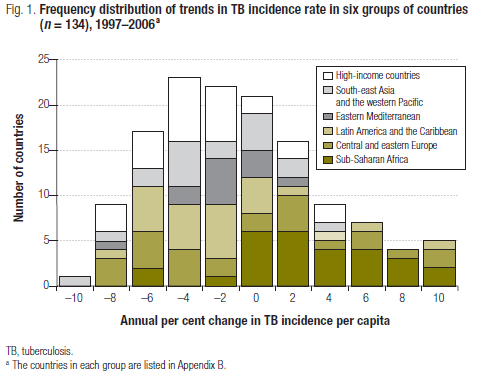
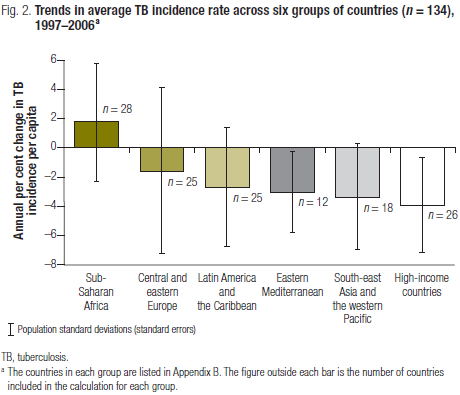
For all 134 countries, 3 of the 32 independent variables were correlated with incidence trends at r2 3 0.2 and P < 0.05 (Table 2). TB incidence was declining more quickly in countries that had a higher human development index, lower child mortality and access to improved sanitation (Fig. 3, Fig. 4 and Fig. 5). Of the three key correlates, only child mortality was retained in the minimal multivariate model (combined model: r2 = 0.32; P < 0.0001; Appendix C). Measures of how intensely TB control programmes were implemented varied widely among countries (e.g. the inter-quartile range for detection of smear-positive cases was 42-82%, and for treatment success among such cases, 73-88%; see also the ranges in Table 1); however, none of the seven direct measures of the intensity of TB control was associated with TB trends worldwide.
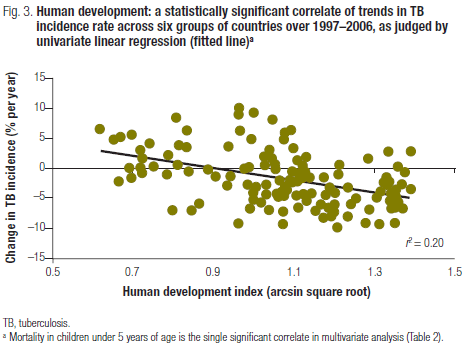
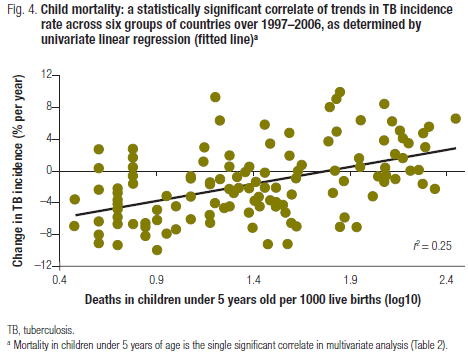
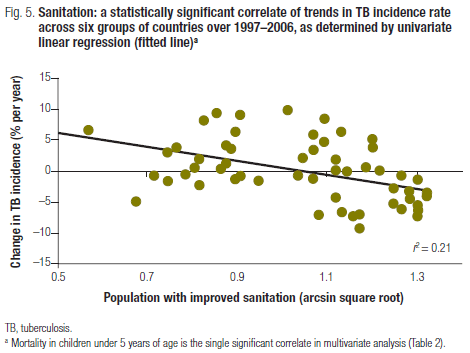
Because statistical significance depends on the magnitude of a biological effect and sample size, significant effects are harder to detect in regions with fewer data (Table 1, Fig. 3, Fig. 4 and Fig. 5). Of 192 possible associations (32 variables across 6 country groups), 2 were significant with the criteria r2 3 0.2 and P < 0.05. In Africa, the number of health workers and the expenditure on TB control per capita were significant correlates of TB incidence trends, but the association was positive: the more workers and the higher the expenditure, the higher the TB incidence (online supporting material, available at: www.who.int/tb/publications/en/).This is probably explained by the positive association between both of these explanatory variables and the prevalence of HIV infection (t > 3.5; P < 0.002). Central and eastern Europe showed the strongest set of associations with TB incidence trends (Table 2). Of the 12 variables that showed significance in the univariate analysis, per capita health expenditure and improved sanitation were dominant in the multivariate regression (r2 = 0.89; P < 0.0001).
Among high-income countries, TB was declining more quickly in countries with fewer immigrants (measured by the proportion of TB patients who were foreign born), and with a higher (not lower) prevalence of diabetes, and both variables were retained in the multivariate model (r2 = 0.79; P < 0.0001). TB trends in the eastern Mediterranean were associated with two related economic variables: GDP and health expenditure in relation to GDP. However, only the latter was retained in the minimal multivariate model.
In Latin America and the Caribbean, univariate analysis showed a correlation between TB trends and nine variables, five of them different from the ones that yielded significance in central and eastern Europe. Another set of five variables was retained in the minimal multivariate model (r2 = 0.96; P = 0.04); one of them - the detection of smear-positive cases - was a direct measure of the intensity of TB control (Table 2).
In south-east Asia and the western Pacific, TB was declining faster in countries with higher child mortality (online supporting material, available at: www. who.int/tb/publications/en/), an association that was not in the expected direction, which was the opposite of that observed in central and eastern Europe, Latin America and the Caribbean, and the world as a whole (Table 2). The association disappeared with the exclusion of one unusual country in the region: the Republic of Korea has low child mortality and low TB incidence, with a flat trend resembling that of some high-income countries.
Discussion
The striking observation in this study was that more than a decade after DOTS was first implemented, with varying levels of national coverage, only one direct measure of TB control intensity (detection of smear-positive cases) in a single region (Latin America and the Caribbean) was associated with a downward trend in TB incidence. None of the seven direct measures of TB programme performance was associated with TB trends globally, although the magnitude of these control variables varied widely among countries. Mathematical modelling suggests that such wide variation should be accompanied by a substantial and measureable difference in incidence (e.g. an increase in the detection rate of smear-positive cases from 42% to 82% should correlate with a decrease in incidence).22 Thus, we conclude that TB diagnosis and treatment programmes, pre- or post-DOTS, have not yet become the principal determinants of TB transmission and incidence trends, though they may do so in the future. Recent trends in TB incidence are, by contrast, more strongly associated with biological, social and economic determinants that differ among countries and regions. The regional differences explain why only three general measures of development were dominant worldwide: the human development index, child mortality and access to improved sanitation.
TB incidence in most countries appears to be declining slowly. Few countries have enjoyed the rates of decline seen in Europe at the start of the chemotherapy era (> 10% per year),4 which are expected to result from DOTS programmes.22 The countries that come closest to these expectations, with a decline > 5% per year, are mostly those that are islands, have a high average income, or are located in central Europe or Latin America and the Caribbean. None are among the 13 WHO high-burden countries investigated here,5 which are mainly in sub-Saharan Africa and in south-east Asia and the western Pacific.
The proposition that TB diagnosis and treatment programmes have not yet become the principal drivers of TB transmission and incidence will remain a hypothesis until four key assumptions can be tested. The first is that trends in case notifications reflect underlying trends in incidence. Some countries clearly had to be excluded from the analysis because their rising trends in case notification (for all forms of TB) obviously reflect improved case finding under DOTS rather than the underlying trend in incidence. Exclusions of this kind eliminate countries where improved case finding is associated with an increase, rather than the expected decrease, in reported cases. For the countries that were included in this analysis, the effect of treatment might not be discernible if a slow decline in TB incidence is masked by a moderate improvement in case detection.
The second assumption, essential in comparative analysis, is that there is measurable and meaningful variation among countries in incidence trends and their determinants. If TB control programmes were uniformly effective, their effectiveness would not be detectable in this analysis, but this seems unlikely because TB incidence is declining slowly and unevenly and because measures of the intensity of TB programme implementation vary greatly among countries. Moreover, our estimates of incidence trends are correlated with numerous biological, social and economic variables, which suggests that these trend estimates do reflect changes in incidence.
A greater potential problem is that the standard direct measures of TB programme performance - mainly case detection and treatment success - are not the best measures of factors that govern disease transmission and changes in incidence. The difficulties of estimating the total number of TB cases that arise each year - the denominator of the case detection rate as defined by WHO - have frequently been described.8,23 In addition, a high case detection rate does not necessarily imply rapid diagnosis; in principle, a large fraction of cases could be detected after long delays, once most infectious contacts in a community have already been made. In cohorts, outcomes are never known for patients who default, are transferred to other treatment centres without follow-up, or are never evaluated. This limits the usefulness of treatment success as a measure that should be inversely associated with infectiousness and transmission. Of 2.3 million patients in the 2005 global DOTS cohort, fewer than 10% had unknown treatment outcomes. However, treatment outcomes were not known for an estimated 1.5 million smear-positive, non-DOTS patients in 2005.5
Third, transmission and the risk of infection may have been greatly reduced by more than a decade of DOTS implementation, but perhaps we have not yet seen the latter's full effect on incidence. In this study, incidence trends were measured as 10-year averages (1997-2006). Some countries did not have wide DOTS coverage for at least the first half of this period and most were treating patients with combination chemotherapy, though not necessarily with the recommended regimens. The alternative explanation is that treatment programmes do not find patients soon enough to substantially reduce transmission.
Fourth, the effect of treating patients to reduce transmission could be offset by factors that increase the risk of developing active TB following infection. Tobacco smoking and diabetes are risk factors for TB, but in this analysis both were associated with declining TB incidence. It may be that these factors reflect social patterns that are linked to health, health services and economic development in ways that override their importance as risk factors for TB. In multivariate analysis, tobacco smoking among women was replaced by factors more closely tied to the real determinants of epidemic TB trends, such as GDP per capita in central and eastern Europe.
Verifying whether trends in case notifications accurately measure trends in incidence calls for detailed studies of the completeness and accuracy of national TB surveillance systems, preferably coupled with surveys of infection, prevalence and mortality.8 The Republic of Korea, which contributes to an unexpected, anomalous and doubtful link between TB and child mortality in Asia, is among the countries whose TB incidence trends need more careful evaluation. Determining whether case detection and treatment success accurately measure the effect of TB programme implementation on transmission calls for examining the entire process of diagnosis and treatment: the identification of suspected cases, delays in diagnosis, procedures for smear microscopy and culture, and treatment initiation and completion. What is required, in short, is a diverse set of studies following those already done, for example, in China, Italy, Peru, South Africa, Spain and Viet Nam.9,24-28 Only with detailed investigations in countries will it be possible to distinguish the effect of TB control programmes from other factors affecting transmission and the progression from infection to active TB.
There are at least four further restrictions on the interpretation of these results. First, the findings of this study do not exclude the possibility that DOTS programmes are relatively weak determinants of TB trends in many countries, with effects that are obscured by other, stronger biological, social and economic factors. Second, this analysis refers to trends in incidence; it says nothing about the number of patients cured or of deaths averted by combination chemotherapy.29,30 Third, we cannot conclude that TB treatment has had no major effect on TB incidence in any country; in fact, national studies (e.g. China and Peru)9,24 and investigations in selected cities (e.g. Beijing and New York)31,32 clearly show that investing in prompt diagnosis and curative treatment can substantially reduce TB incidence in low- and middle-income countries.4,32 Fourth, as in all ecologic studies, strong correlation with TB trends does not necessarily reflect a causal link; conversely, the absence of a correlation does not exclude causality. Nevertheless, it is remarkable that among 25 countries in central and eastern Europe, single variables, such as health expenditure per capita, can explain two-thirds (66%) of the variation in TB trends.
Conclusion
National TB control programmes play a vital role in curing TB patients and preventing deaths; the diagnosis and treatment of active TB have significantly reduced disease transmission and incidence in some countries. However, treatment programmes have not had a major, detectable effect on incidence on a large scale. The possible reasons are that: (i) patients are not diagnosed and treated soon enough to significantly reduce transmission; (ii) case detection, cure and TB incidence trends cannot be measured accurately; (iii) there has been insufficient time to see the effects of reduced transmission; and (iv) any effects on transmission are offset by a growing risk of developing TB following infection. This review presents, not definitive results, but a challenge: to show that early diagnosis and treatment can have a major effect on TB transmission and incidence worldwide, overriding or reinforcing other biological, social and economic determinants of TB epidemiology. 
Acknowledgements
We thank L Blanc, K DeCock, K Floyd, P Nunn, S Ottmani, E Rehfüss, M Uplekar and D Weil for numerous helpful suggestions. The work was funded by WHO.
Competing interests: None declared.
References
1. Millennium development goals indicators [Internet site]. United Nations Statistical Division. Available from: http://millenniumindicators.un.org/unsd/mi/mi_goals.asp [accessed on 18 May 2009] .
2. Dye C, Maher D, Weil D, Espinal M, Raviglione M. Targets for global tuberculosis control. Int J Tuberc Lung Dis 2006;10:460-2. PMID:16602414
3. Raviglione MC, Uplekar MW. WHO's new Stop TB Strategy. Lancet 2006;367:952-5. doi:10.1016/S0140-6736(06)68392-X PMID:16546550
4. Styblo K. Epidemiology of tuberculosis, 2nd ed. The Hague: KNCV Tuberculosis Foundation; 1991.
5. Global tuberculosis control: surveillance, planning, financing. Geneva: World Health Organization; 2008.
6. Cegielski JP, McMurray DN. The relationship between malnutrition and tuberculosis: evidence from studies in humans and experimental animals. Int J Tuberc Lung Dis 2004;8:286-98. PMID:15139466
7. Nunn P, Williams BG, Floyd K, Dye C, Elzinga G, Raviglione MC. Tuberculosis control in the era of HIV. Nat Rev Immunol 2005;5:819-26. doi:10.1038/ nri1704 PMID:16200083
8. Dye C, Bassili A, Bierrenbach AL, Broekmans JF, Chadha VK, Glaziou P, et al. Measuring tuberculosis burden, trends and the impact of control programmes. Lancet Infect Dis 2008;8:233-43. doi:10.1016/S1473-3099(07)70291-8 PMID:18201929
9. China Tuberculosis Control Collaboration. The effect of tuberculosis control in China. Lancet 2004;364:417-22. doi:10.1016/S0140-6736(04)16764-0 PMID:15288739
10. Human development report 2007/2008. New York, NY: United Nations Development Program; 2007.
11. Corruption perception index. Berlin: Transparency International; 2008. Available from: www.transparency.org/policy_research/surveys_indices/cpi [accessed 18 May 2009] .
12. World development indicators 2007. Washington, DC: The World Bank; 2007.
13. Euro TB and the national coordinators for tuberculosis surveillance in the WHO European Region. Surveillance of tuberculosis in Europe: report on tuberculosis cases notified in 2005. Paris: Institut de Veille Sanitaire; 2007.
14. Reported tuberculosis in the United States, 2006. Atlanta: Centers for Disease Control and Prevention; 2007.
15. WHO report on the global tobacco epidemic 2008: the MPOWER package. Geneva: World Health Organization; 2008.
16. Rehfuess E, Mehta S, Pruss-Ustun A. Assessing household solid fuel use: multiple implications for the Millennium Development Goals. Environ Health Perspect 2006;114:373-8. PMID:16507460
17. National health accounts. Geneva: World Health Organization; 2007.
18. World health statistics. Geneva: World Health Organization; 2007.
19. Slama K, Chiang C-Y, Enarson DA, Hassmiller K, Fanning A, Gupta P, et al. Tobacco and tuberculosis: a qualitative systematic review and meta-analysis. Int J Tuberc Lung Dis 2007;10:1049-61.
20. Lin HH, Ezzati M, Murray M. Tobacco smoke, indoor air pollution and tuberculosis: a systematic review and meta-analysis. PLoS Med 2007;4:e20. doi:10.1371/journal.pmed.0040020 PMID:17227135
21. Stevenson CR, Critchley JA, Forouhi NGRG, Williams BG, Dye C, Unwin NC. Diabetes and the risk of tuberculosis: a neglected threat to public health? Chronic Illn 2007;3:228-45. doi:10.1177/1742395307081502 PMID:18083679
22. Dye C, Garnett GP, Sleeman K, Williams BG. Prospects for worldwide tuberculosis control under the WHO DOTS strategy: directly observed short-course therapy. Lancet 1998;352:1886-91. doi:10.1016/S0140- 6736(98)03199-7 PMID:9863786
23. Borgdorff MW. New measurable indicator for tuberculosis case detection. Emerg Infect Dis 2004;10:1523-8. PMID:15498151
24. Suarez PG, Watt CJ, Alarcon E, Portocarrero J, Zavala D, Canales R, et al. The dynamics of tuberculosis in response to 10 years of intensive control effort in Peru. J Infect Dis 2001;184:473-8. doi:10.1086/322777 PMID:11471105
25. Botha E, Den Boon S, Dye C, Lawrence KA, Reuter H, Verver S, et al. From suspect to patient: tuberculosis diagnosis and treatment initiation in primary health care facilities in South Africa. Int J Tuberc Lung Dis 2009;13:670.
26. Migliori GB, Spanevello A, Ballardini L, Neri M, Gambarini C, Moro ML, et al. Validation of the surveillance system for new cases of tuberculosis in a province of northern Italy. Varese Tuberculosis Study Group. Eur Respir J 1995;8:1252-8. doi:10.1183/09031936.95.08081252 PMID:7489786
27. Inigo J, Arce A, Martin-Moreno JM, Herruzo R, Palenque E, Chaves F. Recent transmission of tuberculosis in Madrid: application of capture-recapture analysis to conventional and molecular epidemiology. Int J Epidemiol 2003;32:763-9. doi:10.1093/ije/dyg098 PMID:14559746
28. Huong NT, Duong BD, Co NV, Quy HT, Tung LB, Broekmans JF, et al. Tuberculosis epidemiology in six provinces of Vietnam after the introduction of the DOTS strategy. Int J Tuberc Lung Dis 2006;10:963-9. PMID:16964785
29. Khatri GR, Frieden TR. Controlling tuberculosis in India. N Engl J Med 2002;347:1420-5. doi:10.1056/NEJMsa020098 PMID:12409545
30. Dye C, Watt CJ, Bleed DM, Hosseini SM, Raviglione MC. Evolution of tuberculosis control and prospects for reducing tuberculosis incidence, prevalence, and deaths globally. JAMA 2005;293:2767-75. doi:10.1001/ jama.293.22.2767 PMID:15941807
31. Zhang LX, Tu DH, Enarson DA. The impact of directly-observed treatment on the epidemiology of tuberculosis in Beijing. Int J Tuberc Lung Dis 2000;4:904-10. PMID:11055756
32. Frieden TR, Fujiwara PI, Washko RM, Hamburg MA. Tuberculosis in New York City - turning the tide. N Engl J Med 1995;333:229-33. doi:10.1056/ NEJM199507273330406 PMID:7791840
(Submitted: 2 September 2008 - Revised version received: 10 December 2008 - Accepted: 15 December 2008 - Published online: 30 June 2009)
* Correspondence to C Dye (e-mail: dyec@who.int).
